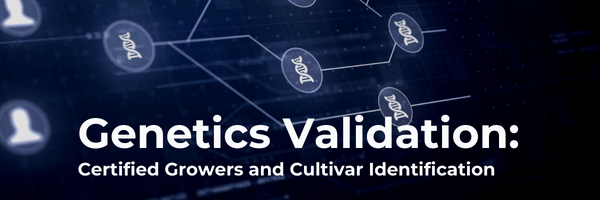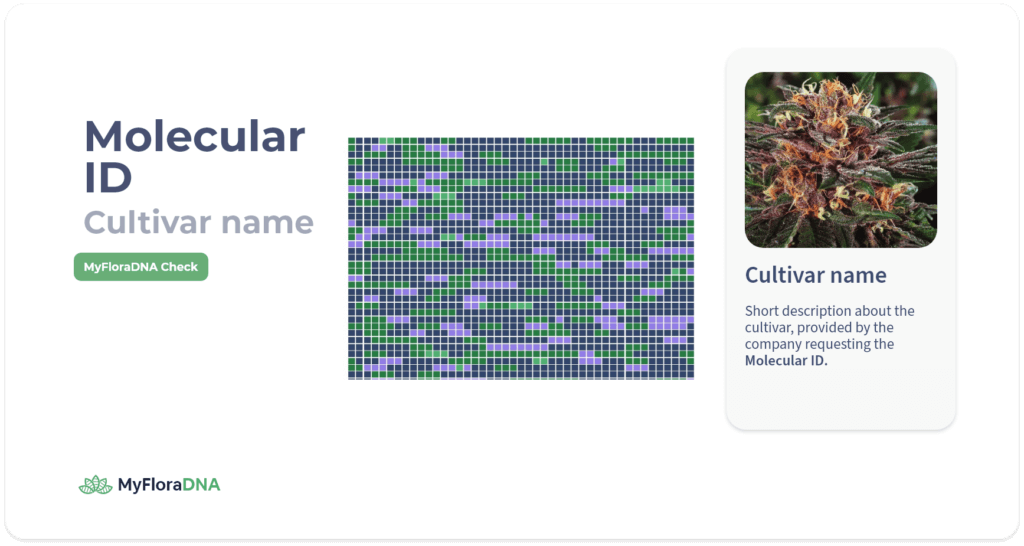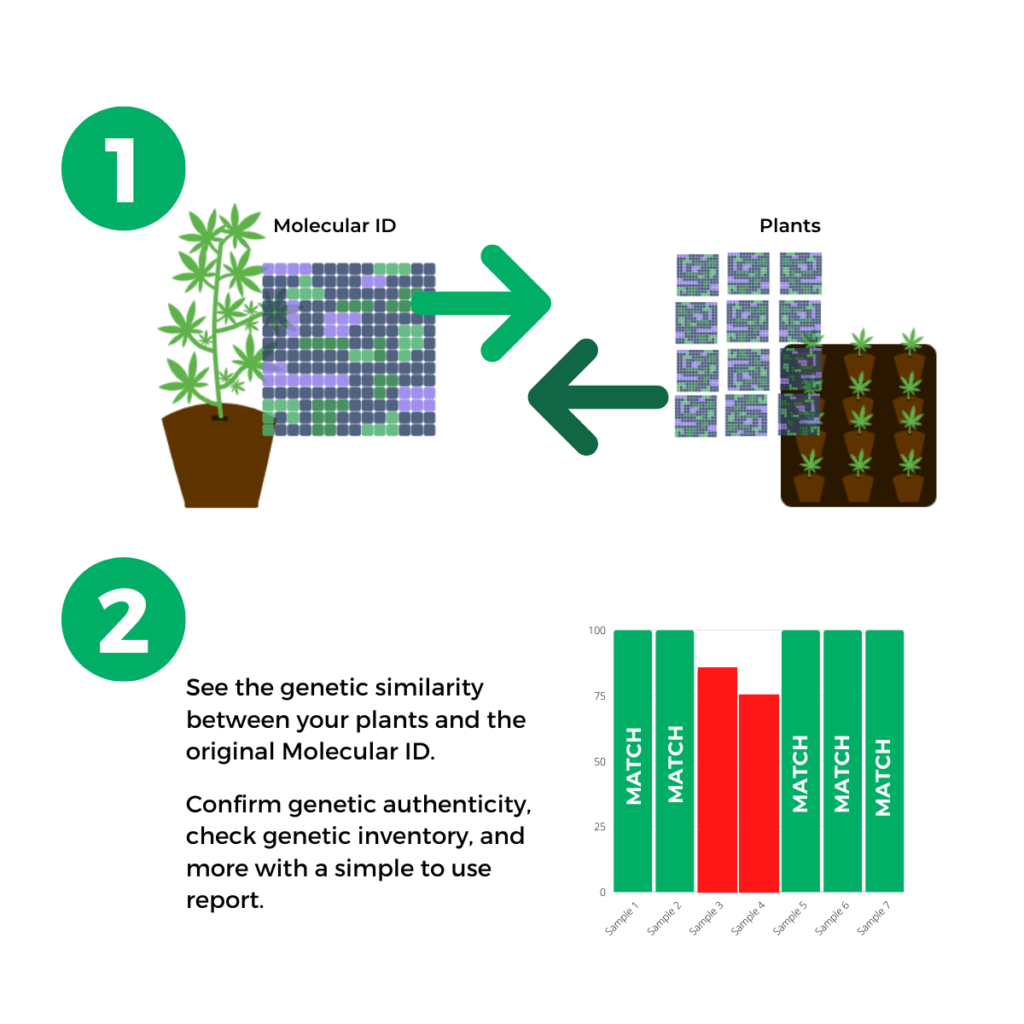by María Zuccarelli and María Belén de Catarina, MyFloraDNA

It’s pretty easy to differentiate humans from one another, except for twins, that’s a more tricky situation.
With plants, it is not that easy. It takes time and a lot of expertise to differentiate each species. Imagine the difficulty to distinguish with 100% precision one cultivar from another within the same species!
Cannabis breeders, nurseries, and growers face this challenge from the beginning of their journey, cultivating and developing new cultivars.
It’s a fact that nowadays people do not know exactly which cultivar (miss-called strain) is growing, much less what they are actually consuming.
You can find out which cultivar you are growing by determining physical attributes such as smell, color, leaf shape, etc.
“Online databases such as Leafly (2018) and Wikileaf (2018), for example, provide consumers with information about strains but lack scientific merit for the cannabis industry to regulate the consistency of strains.” affirms Schwabe and McGlaughlin (2019).
Over time, cannabis growers and geneticists realized the importance of finding an efficient way to determine the genotype of a plant accurately.
Other industries use DNA Fingerprinting to differentiate cultivars and effectively categorize and relate them. They’ve realized that this solution works identically to physical fingerprints, so it can be used to identify cultivars or genes among generations.
But, how can we use genomic images for the cannabis business?
- Identification of cannabis cultivars using their unique genetic profile
- Identification of plant species, varieties, clones, individuals, and even plant products
- Guarantee genetic quality and ownership
- Authenticate the nature and origin of the plant
- Validate the genetic inventory and stockage
- Register and protect new cannabis cultivars
- Construction of evolutionary and phylogenetic trees
The main goal of this application is to protect the breeders and provide recognition to the creators of the new plant cultivars. Also, this analysis can lead to conscious consumption in this industry and highlight the positive effects that cannabis can have on society.
“Currently, the Cannabis industry has no way to verify strains. Consequently, suppliers are unable to provide confirmation of strains, and consumers have to trust the printed name on a label matches the product inside the package,” says Schwabe and McGlaughlin (2019).
It is important to move towards responsible cannabis production, where growers and consumers know what effect our products will cause. Recognizing precisely what cultivar growers and nurseries are growing and selling is our responsibility.
For this, the DNA fingerprint is a very useful tool. It allows the cannabis industry to build a responsible and conscious production system. Let’s Imagine the power to know in advance which cultivars have to cross to obtain a new one that enhances/improves the final effects and experiences patients and recreational users will have. This is possible if we effectively characterize, define, and categorize each cultivar.
Dr. Angel Fernandez, a plant scientist from UC Berkeley and Co-Founder of MyFloraDNA, discovered and patented a process based on DNA fingerprinting that enables him to build a genetic image representing a cannabis cultivar’s simplified genome. He calls it “Molecular ID.” Every single cultivar already has its own genomic and unique logo inside them, this solution enables us to see it.

In the image, each square represents a molecular DNA marker and the whole combination of squares are unique to every cultivar. Two different cultivars with the same Molecular ID do not exist, that’s what makes it interesting.
Angel discovered that this particular code could be used in more than one way, bringing the cannabis industry new ideas and solutions. It is a universal code that serves to compare and differentiate cannabis cultivars.
Using the Molecular ID, breeders will be able to capture their plants’ genomic logo, using it as a reference, ID, or even a comparison method. The most important thing about this new technique is that everybody will be able to use it as a standardized genomic procedure for their genetics.

Example about one application of Molecular ID
Like everything in the cannabis industry, nothing is possible without the collaboration of all different players. Let’s continue building a conscious and more efficient and sustainable industry.
If you’re curious and would like to know more about this new solution, download our free ebook to read more about how to use genomic information to take your cannabis business to the next level by clicking here.
What do you think about this new genomic solution? Is it going to be even more confusing or helpful?
We’re delighted to read your opinions
 About MyFloraDNA: We are a genomic laboratory based in Woodland California, delivering modern genomics for the Cannabis Industry. \
About MyFloraDNA: We are a genomic laboratory based in Woodland California, delivering modern genomics for the Cannabis Industry. \
Our services include Trait detection (cannabinoid profile and sex/gender ID), Pathogen Detection, and Genetic Validation Services. We offer breakthrough solutions using the inner power of your plants.
Author: María Zuccarelli – Marketing Manager at MyFloraDNA.
Marketing expert, with a portfolio of innovative and successful projects around the world. Native leader, resolutive and efficient. She brings creativity and proactivity to MyFloraDNA’s Marketing Department.
Co-author: María Belén de Catarina
Editor: Ashlyn East and Juana Daroda


Follow NCIA
Newsletter
Facebook
Twitter
LinkedIn
Instagram
–